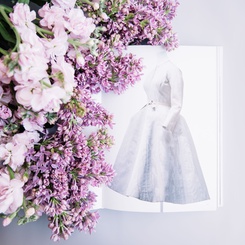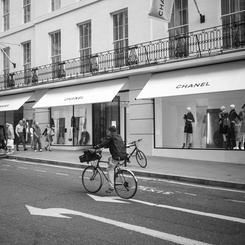Recent years have seen Tiffany—once considered a status symbol reserved for the elite—lose its luster. But the $15.8 billion acquisition by luxury conglomerate LVMH aims to rejuvenate its image and restore Tiffany to its position as one of the world’s most desirable jewelry houses.
Does the mention of “Tiffany and Co” conjure up images of a robin’s-egg blue box and Audrey Hepburn? You wouldn’t be alone - the brand has well-established visual codes that have cemented its identity.
In one study, the mere sight of an empty Tiffany’s box got hearts racing. The participants didn’t just see a color or a box: it evoked love, romance, luxury, getting engaged. This demonstrates just how deeply the Tiffany brand resonates with people and how it makes them dream of the possibilities contained in that little blue box. Despite this, Interbrand only valued the company at US$5.6 million in 2018, a dip from its peak of US$6.3 million in 2015. Then in 2019, Tiffany’s didn’t make the Forbes Most Valuable Brand list.
Now, the LVMH Group is well known for rejuvenating some of the world’s most desirable brands today and we are already seeing this rejuvenation starting to happen with Tiffany’s, with a formula designed to restore its luster and increase its desirability. This formula involves digging deeper into the brand DNA, using the aforementioned visual codes and introducing some new ones, and enhancing the brand storytelling to tell a richer story of love and luxury and expand the brand universe. To do this, they will need to draw on Tiffany’s rich history: going back almost two centuries - a dream for luxury marketing.
In 1845, Tiffany’s launched the Blue book, cataloging ornate gems and silvers, and in 1867, it made its mark by securing the grand prize for silver craftsmanship at the 1867 Paris World Fair. In 1878, the brand acquired one of the largest yellow diamonds ever discovered, and in 1886, it introduced the world’s first modern diamond engagement ring, forever changing what we picture when we pop the question. And who could forget 1961’s Breakfast at Tiffany’s, with a luminous Audrey Hepburn admiring the window displays of the New York flagship store?
These milestones, coupled with the brand’s connections to big names like Elsa Peretti and Paloma Picasso, cemented the brand’s reputation and the quality of its products. LVMH can use this history and brand recognition to help Tiffany’s regain its former glory. But there is also an opportunity here to expand their product universe with a new creative director, one that will bring a more creative appeal to the product offer, somebody with the appeal and the unique aesthetic alike to the one of the legendary French designer Jean Schlumberger. A highly visible creative director, or even a collection director is not necessarily the norm in high jewelry brands. However, a fresh aesthetic that is inspired by the brand DNA might also help the brand rejuvenation.
Another element is the place where it all started - New York. The connection to New York is also a key element of their DNA, and the brand is increasingly weaving New York into its marketing. The spirit of New York appeals to many consumers - in a similar vein, brands like Chaumet and Dior have Paris and Parisian style as a part of their DNA. We can already see more of the links with New York in the more recent ads from the brand.
After all, this rich history is embedded in the DNA of the brand, distinguishing it from its competitors. The DNA also serves as a guideline of where and how far the brand should go. Understanding this DNA and weaving it through every single product and experience that Tiffany’s offers, helps create a compelling and coherent story that attracts clients and inspires them to dream bigger - and buy more from the brand.
For centuries, Tiffany’s has told a story of love— but while love may conquer all, it’s a promise sold by jewelers all over the world, not just Tiffany’s. There was a need to deepen this promise and present it in a more desirable way. One element is modernizing the way they represent love in their marketing campaigns to appeal to a diverse modern clientele. Consumers today want to be seen and represented, and modern brands need to respond to this need.
Tiffany’s 2015 "Will You?" ad campaign made a stride toward this by featuring a same-sex couple - this was a start to establishing Tiffany’s as a heritage brand with its feet in the 21st century. The ads may have been more relatable - but there needs to be more where that came from. They built on this with their 2021 “ABOUT LOVE” campaign, complete with a film starring Beyonce and Jay-Z. The star-studded reputation of the couple speaks volumes about not just love, but also aspiration. September and October 2022 have brought us another Beyoncé campaign, “Love Yourself in Love”, all about empowerment and celebrating oneself - with diamonds, of course. We can expect more of these meaningful collaborations, with true love stories that elevate the brand's desirability.
Radiating with new visual codes
This focus on history will trickle down to the visual codes used across the Tiffany universe. A visual code is something we see that calls to mind the brand: some of the older Tiffany codes included the key pendant, the letter “T”, and the heart bracelet. The brand has always focused on the Tiffany diamond as one of their iconic products. However, this is hard to push forward as a strong code because it is not visible to the naked eye - to be truly iconic, codes need to be unique and easily recognizable. These codes are being refreshed to better appeal to modern consumers with the new Tiffany Knot collection. Inspired by the chain-link fences in New York City, this collection is an ode to the city’s edginess and strength. Another example is the most recent launch, the Tiffany Lock, a unisex bangle inspired by another strong element which seams to be permeating the brand - that of togetherness and inclusivity.
The brand has also been playing with the brand’s most iconic code of all: the signature robin’s-egg blue shade. The Blue Box, Circa 3021 collaboration with Daniel Arsham for the Tiffany Knot collection saw Arsham put his own spin on the Tiffany Blue Box, giving it a distressed, aged quality, symbolic of its long history. More daring still was the brand’s April Fool’s strategy, turning their shops yellow. Besides gaining massive media traction, this served as a marketing push for yellow diamonds. One code that offers great potential to inspire the entire collection is the famous ‘Bird on a rock’, initially designed by Jean Schlumberger and one of his most iconic pieces.More recently, Tiffany & Co. adapted the Bird on a Rock design for a pair of one-of-a-kind cufflinks worn specifically for the About Love campaign by Jay-Z. However, there could be an entire collection of pendants, earrings, bracelets and even watches featuring ‘Bird on the Rock’. Animal codes can be very powerful and in some cases could open up a world of possibilities for the brand like what Serpenti code did for Bulgari and Panther for Cartier.
Transforming the Tiffany universe
After new communications and new product launches, one possible next step is for the brand to roll out a massive plan of store revamping, which includes assessing locations and introducing new formats.
Tiffany’s iconic flagship on New York’s Fifth Avenue is currently undergoing a massive renovation with LVMH’s architect of choice, Peter Marino. In addition, Tiffany’s is already playing around with different formats, such as the pop-up store on Avenue Montaigne in Paris, open until May 2023. The pop-up store will change themes several times throughout the year, kicking off with the “Paris in love” theme. It will feature many iconic pieces from the archives including a ‘Bird on the Rock,’, but also with some of the new high-end jewelry pieces. These temporary pop-ups are a great way to freshen up the brand’s image, tantalize clients in a new way, and get them to see the brand in a new light.
Ultimately, building a brand and establishing it as high-end is a long-term strategy, but all of these small steps are in the right direction, leading Tiffany back to a position alongside names like Cartier, Bulgari and Van Cleef & Arpels as one of the most desirable jewelry houses in the world.








